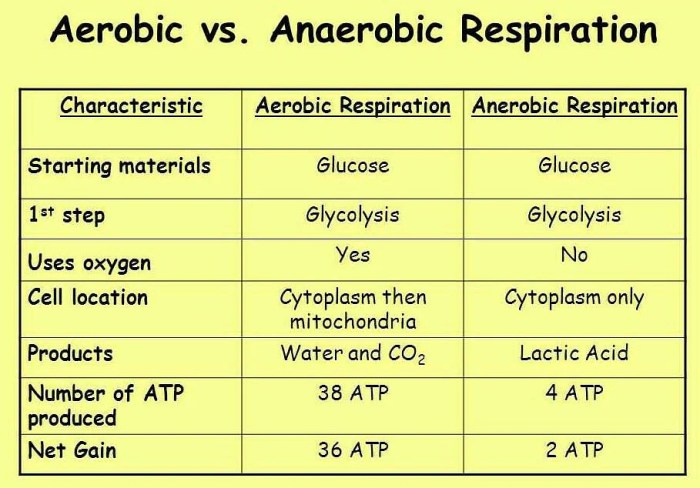Cellular respiration reading comprehension article embarks on an enlightening journey into the intricate world of cellular respiration, a fundamental process that fuels life and underpins the very existence of living organisms.
This comprehensive article delves into the fascinating stages of cellular respiration, from glycolysis to oxidative phosphorylation, unraveling the intricate mechanisms that govern energy production within cells.
Cellular Respiration Overview

Cellular respiration is a fundamental process that occurs in all living organisms, converting biochemical energy from nutrients into adenosine triphosphate (ATP), the primary energy currency of cells. This process plays a crucial role in maintaining cellular homeostasis, driving metabolic reactions, and supporting the overall functioning of organisms.
Cellular respiration involves three main stages: glycolysis, the Krebs cycle (citric acid cycle), and oxidative phosphorylation. Each stage serves a specific role in the breakdown of glucose, the primary energy source for most organisms, and the generation of ATP.
Glycolysis
Glycolysis is the first stage of cellular respiration and occurs in the cytoplasm. It involves the breakdown of one molecule of glucose into two molecules of pyruvate. During glycolysis, a net gain of two molecules of ATP and two molecules of NADH (nicotinamide adenine dinucleotide), an energy-carrier molecule, occurs.
Krebs Cycle (Citric Acid Cycle)
The Krebs cycle takes place in the mitochondria and plays a central role in the generation of energy-carrier molecules. During the Krebs cycle, pyruvate molecules from glycolysis are further broken down and combined with coenzyme A to form acetyl-CoA. The acetyl-CoA then undergoes a series of reactions, resulting in the production of one molecule of ATP, three molecules of NADH, and one molecule of FADH2 (flavin adenine dinucleotide), another energy-carrier molecule.
Oxidative Phosphorylation
Oxidative phosphorylation is the final stage of cellular respiration and occurs in the inner mitochondrial membrane. It involves the transfer of electrons from NADH and FADH2 through an electron transport chain, which generates a proton gradient across the membrane. The proton gradient drives the synthesis of ATP through a process known as chemiosmosis.
Factors Affecting Cellular Respiration, Cellular respiration reading comprehension article
The rate of cellular respiration can be influenced by several factors, including:
- Temperature:Higher temperatures generally increase the rate of cellular respiration, as enzymes involved in the process are more active.
- Oxygen availability:Cellular respiration requires oxygen as a final electron acceptor. Limited oxygen availability can slow down or even inhibit the process.
- Substrate concentration:The availability of glucose or other substrates for cellular respiration can affect its rate. Higher substrate concentrations typically lead to increased respiration rates.
Regulation of Cellular Respiration
Cellular respiration is tightly regulated to ensure that the energy demands of cells are met. This regulation involves feedback mechanisms, enzymes, and hormones.
- Feedback mechanisms:The products of cellular respiration, such as ATP and NADH, can inhibit enzymes involved in the process, slowing it down when energy levels are sufficient.
- Enzymes:Enzymes play a crucial role in regulating the rate of cellular respiration. Their activity can be influenced by factors such as temperature, pH, and the presence of inhibitors or activators.
- Hormones:Hormones, such as insulin, can stimulate or inhibit cellular respiration, depending on the energy needs of the body.
Importance of Cellular Respiration
Cellular respiration is essential for maintaining life. It provides the energy required for essential cellular processes, including:
- Metabolism:Cellular respiration provides the energy for metabolic reactions, such as protein synthesis, lipid metabolism, and nucleic acid synthesis.
- Muscle contraction:Cellular respiration is essential for muscle contraction, providing the energy for movement.
- Ion transport:Cellular respiration provides the energy for ion transport across cell membranes, maintaining cellular homeostasis.
Applications of Cellular Respiration
The understanding of cellular respiration has had numerous applications in various fields:
- Medicine:Understanding cellular respiration has led to the development of drugs and treatments for metabolic disorders and diseases such as cancer.
- Biotechnology:The principles of cellular respiration are used in biotechnology applications, such as biofuel production and the development of genetically modified organisms.
- Environmental science:Cellular respiration is studied to understand the role of organisms in ecosystems and the impact of environmental factors on respiration rates.
User Queries: Cellular Respiration Reading Comprehension Article
What is the significance of cellular respiration?
Cellular respiration is essential for life as it provides the energy that fuels cellular processes, enabling organisms to grow, reproduce, and maintain homeostasis.
How does glycolysis contribute to cellular respiration?
Glycolysis is the first stage of cellular respiration and involves the breakdown of glucose to produce pyruvate, energy molecules (ATP), and reducing equivalents (NADH and FADH2).
What is the role of the Krebs cycle in cellular respiration?
The Krebs cycle, also known as the citric acid cycle, is a series of chemical reactions that further break down pyruvate to produce energy-carrier molecules (ATP, NADH, and FADH2).
How does oxidative phosphorylation generate energy in cellular respiration?
Oxidative phosphorylation is the final stage of cellular respiration and involves the transfer of electrons through the electron transport chain, leading to the production of ATP.

